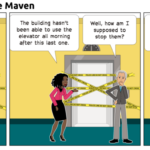Businesses are anxiously awaiting the ability to resume operations. While States continue discussions to reopen their economies, it is essential for business owners to ensure that they are truly ready to operate in the Post-COVID reality. Here are 10 issues to be mindful of as you make your preparations.
1. Will You Enforce Restrictions on Office/Building Visitors? Determining what, if any, restrictions you will impose on third parties that visit your premises goes to the heart of protecting both your employees and your customers. What type of access will others have? For example, will vendors such as food delivery and mail carriers, be permitted inside or will deliveries be left outside the front door? Will you require visitors to wear masks? Establish the standard that you will apply to your workplace and communicate it clearly to visitors, vendors and customers.
2. Will Your Workplace Need to be Reconfigured? It is time to review your business floor plans to help keep people far enough apart from each other so they feel safe. So whether you’re a restaurant and need to remove tables so that your inside dining customers are further apart or you’re a business office that previously had employees sharing cubicles or office space, it will likely be necessary to make changes to your current layout to allow for physical distancing.
3. Is Your Workplace Prepared to Promote Healthy Practices? It is important to prioritize cleanliness practices to keep the work environment sanitized. For instance, have you installed hand sanitizer dispensers throughout your facility? Will you clean, carpets, floors and furniture at a certain frequency? Should you close communal spaces like the kitchen or conference rooms? Ensuring cleanliness and providing appropriate supplies to maintain hygiene practices will be key to keeping your employees healthy.
4. Do You Have a Workplace Safety Plan? In order to prevent exposure to workforce, you should establish preventative standards in a formalized plan. For instance, will temperatures be taken, or will you even go as far as conducting COVID testing at work? Recent guidance from the EEOC indicates that Employers can do both, but what makes sense for your business. How often will the premises be cleaned/disinfected? What will be the process for employees to express safety concerns? In addition to your plan, consider appointing a COVID-19 Point Person who will be responsible for enforcing the plan.
5. Do You Have an Exposure Plan? You should be clear on what you will do if there is an individual that becomes positive in the workplace. What process will you undertake to determine the extent of exposure to the rest of your workforce while at the same time minimizing potential risks to others? It is advisable to establish policies and protocols beforehand such as requiring employees to notify HR immediately if they are experiencing symptoms as well as what will be the process for sending employees to quarantine based on CDC guidelines.
6. Have You Considered Which Roles Can Remain Remote? While businesses will be reopening, the consistent guidance continues to encourage remote work whenever possible and feasible with business operations. But remember, whether you’ve already had workers working remotely or will begin to, it’s prudent to establish a standard to objectively determine which tasks and positions can be remote and evaluate the disparate impact of those decisions to avoid running afoul of discrimination claims. P.S. a remote work policy is also recommended and can help from many issues including overall compliance.
7. Have You Thought About How Employees Will Return? Establishing and communicating a protocol for how employees will be entering the workplace can help support physical distancing. For example, are you able to assign different entry points for different departments? Can you stagger start times to minimize morning traffic into the building? Will you limit re-entry if a worker leaves during the day? Determining these standards beforehand can help limit exposure to workers.
8. Which Employees Will Be Recalled to Work? Be careful to consider return decisions in a non-discriminatory way. Do not make assumptions about “at risk” categorized employees or parents with children at home as that can result in unintentional discrimination. Instead, consider using objective factors such as jobs or tasks that can’t or shouldn’t be done remotely; or selections based on date of hire. The less person-specific the decisions are, the better.
9. Have You Revised Your Work Policies? Along with this unprecedented pandemic comes unprecedented workplace situations and corresponding legislation that now applies to many businesses. Examples are the new Emergency Sick Leave and Extended FMLA that apply to businesses with 500 or less employees. Do you have a full understanding of how to administer rights under these legislations? Does your handbook reflect the application of these new laws? Have you established a process in which employee requests will be reviewed, approved and tracked? Who will manage this process? Appropriately documenting these policies will help you steer clear of compliance issues.
10. Do You Have a Written Plan? Last, but not least, creating a COVID-19 Operations Playbook incorporating the protocols and practices you’ve established on all of the topics above should be the first step for any business that will bring back their employees and begin to once again provide services to customers. Taking it a step further, training your employees on these new standards is just as important to ensure that everyone understands expectations.
While the areas addressed above are certainly not exhaustive, it certainly captures many of the issues businesses will have to tackle as they reopen. Preparing appropriately will demonstrate to your employees and customers that you have been thoughtful in establishing the safest environment possible.
Need to update your policies or help with best-practice guidance on reopening your workplace? The HR & Beyond team is here to assist. Find out more at www.hrandbeyond.com or email us at info@hrandbeyond.com.





